Ireland, Part 2
Where the 12th Century is just a few blocks down the road.
Note: For an overview of where this series is going and what you can expect going forward, we recommend you read Part 1 before proceeding.
As we descended into Shannon Airport, Clare County, Ireland after an all night flight from California, we had our doubts about the trip on which we were about to embark. The western coast of Ireland, where we were touching down, had a reputation for showers and gloomy skies—even in late summer. Those in our party who favored warmer climes with beaches and outdoor activity wondered how they would adapt over the next few days. Of if they even would.
The driver who picked us up at the airport—a talkative fellow who appeared to confirm the open, friendly reputation of the Irish people—helped settle our mood even as he whisked us away through (sure enough) curtains of mist on the 30 minute drive to the Old Ground Hotel. Of course we were on the lookout for convenience stores as we motored forward, and while we did see a few gas stations with brand names like Top and Topaz, they weren’t compelling enough for us to shout, “Stop the car!” (They were, however, spotless. We found out later the same can be said for most of Ireland.)
Any misgivings we may have had were tempered by our destination for the first two nights, Ennis. It embodies much of what makes Ireland so attractive: friendly people; unique retailers in pocket-sized shops; and most appealing to those of us staggering around with 10 a.m. jet lag, compactness. Our hotel room looked out on the heart of downtown, and we could see it was stuffed with colorful buildings and crisscrossed by incredibly narrow streets meaning you could visit dozens of locations in a few block walk. To our out-of-tune bodies and clouded minds, that was perfect.
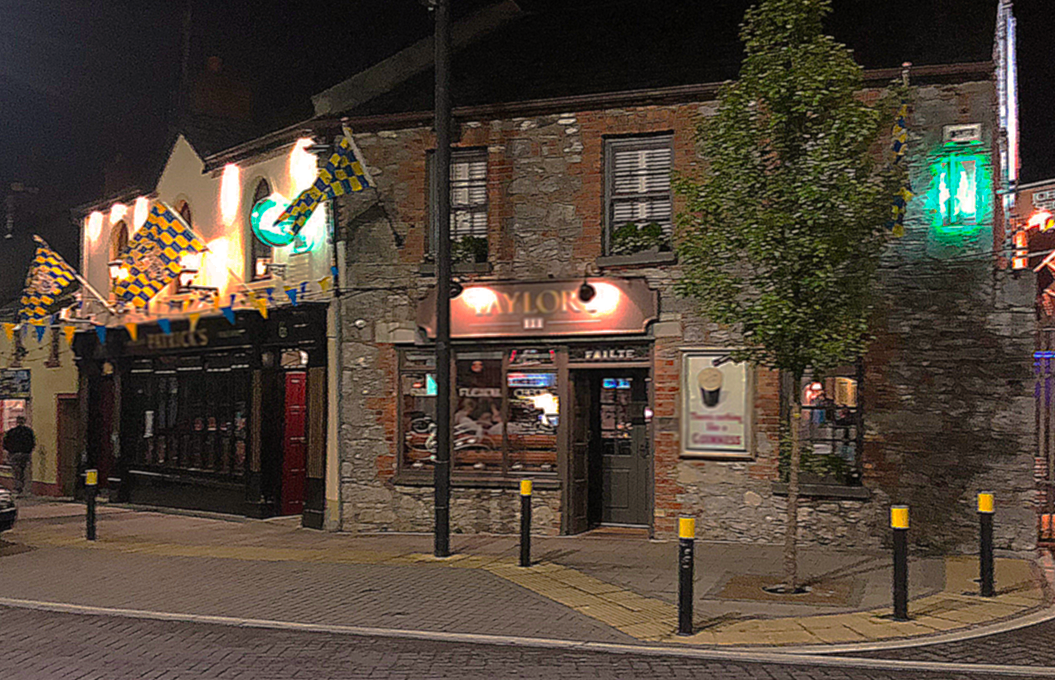 After a lunch of tremendous portions at our hotel, which included two yam-sized fillets of a fish called Plaice, we headed to our rooms and immediately collapsed into a coma-like sleep knowing our tour wouldn’t begin until 2:00 p.m. the next day. Not wanting to cause our biological clocks any further disruption, however, we forced ourselves to get up at six p.m. Knowing that in summertime Ireland doesn’t get dark until almost 10, we ventured out to see part of a community that dates back to at least to the 12th century, when the O’Brien clan more or less founded it.
After a lunch of tremendous portions at our hotel, which included two yam-sized fillets of a fish called Plaice, we headed to our rooms and immediately collapsed into a coma-like sleep knowing our tour wouldn’t begin until 2:00 p.m. the next day. Not wanting to cause our biological clocks any further disruption, however, we forced ourselves to get up at six p.m. Knowing that in summertime Ireland doesn’t get dark until almost 10, we ventured out to see part of a community that dates back to at least to the 12th century, when the O’Brien clan more or less founded it.
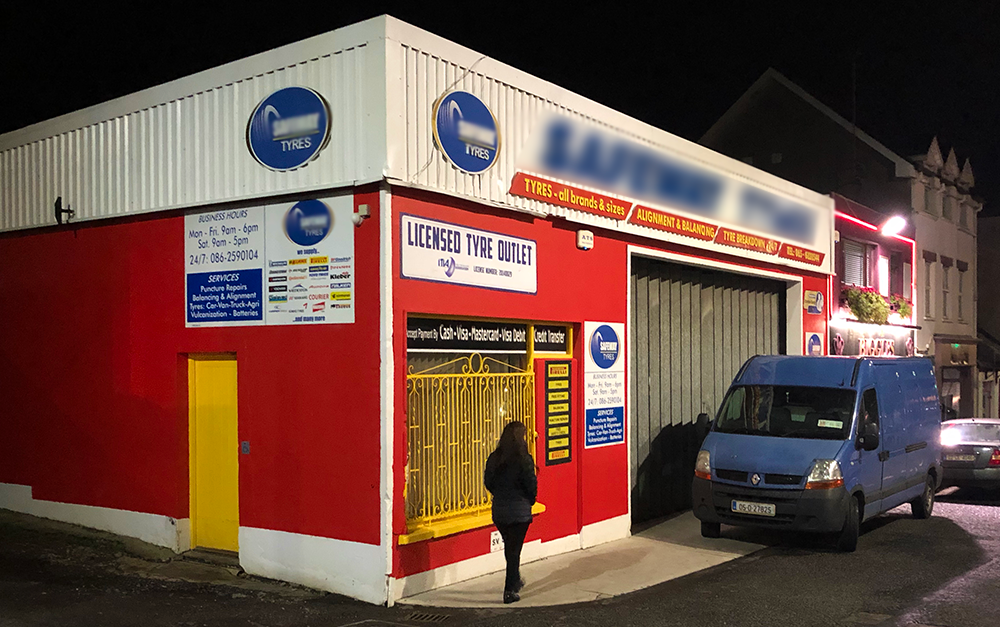 As it was Sunday night, we expected the slender streets to be dead, but we were dead wrong. Despite the comings and goings of light showers, pubs were bustling and people filled the streets, some with pint glasses in hand. The aroma of cigarette smoke hung above us as variations on the template of Irish traditional music seeped out of every space in every block. With its dozens of half-hidden alleys and store fronts squeezed together like paperbacks on a bookshelf—including automotive repair—er, tyre—facilities, Ennis fit the archetype of a small Irish town, at least in our minds, and we found that very pleasant.
As it was Sunday night, we expected the slender streets to be dead, but we were dead wrong. Despite the comings and goings of light showers, pubs were bustling and people filled the streets, some with pint glasses in hand. The aroma of cigarette smoke hung above us as variations on the template of Irish traditional music seeped out of every space in every block. With its dozens of half-hidden alleys and store fronts squeezed together like paperbacks on a bookshelf—including automotive repair—er, tyre—facilities, Ennis fit the archetype of a small Irish town, at least in our minds, and we found that very pleasant.
On the walk back for a nightcap in our hotel’s pub (a very nice one!), we were afforded a spectacular view of the Cathedral of Saints Peter and Paul right across from our hotel, bedecked gloriously in amber light.
The cathedral was first used for Mass in 1842. Its striking facade and immediate surroundings are augmented by a pair of human hands, sculpted out of stone in 2008. We found out that these go by several names, including “Hands of Welcome” and “Hands of Peace.” Look closely and you’ll see them in the lower left hand corner, dwarfed by the majesty of the cathedral.
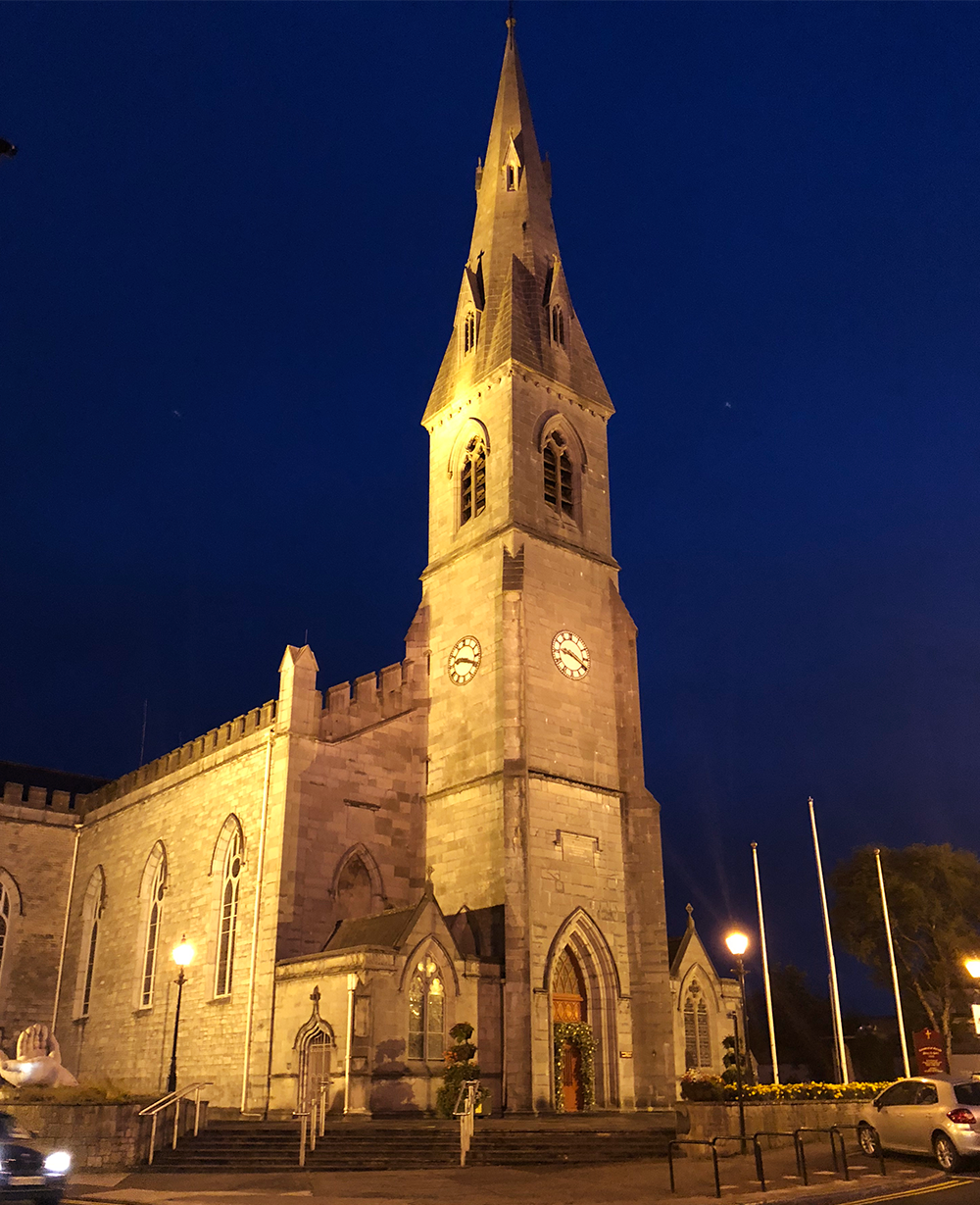 The next morning, after a good night’s sleep and hearty Irish breakfast (is there any other kind?) some of us went out for a drizzly morning walk. In contrast to the hazy, musical buzz that greeted us the night before, we found the town quiet and deserted…well, almost. One gentleman kept screaming “Good Morning!” to no one in particular, and another, whose resonant singing voice echoed out of the alley in which he was shuffling back and forth, leg to leg, filled the streets with an early benediction for the town and its visitors. Though displaying behavior that one might call “non-standard,” both gents gave off an open, almost warm vibe, which was new to us and a little difficult to reconcile.
The next morning, after a good night’s sleep and hearty Irish breakfast (is there any other kind?) some of us went out for a drizzly morning walk. In contrast to the hazy, musical buzz that greeted us the night before, we found the town quiet and deserted…well, almost. One gentleman kept screaming “Good Morning!” to no one in particular, and another, whose resonant singing voice echoed out of the alley in which he was shuffling back and forth, leg to leg, filled the streets with an early benediction for the town and its visitors. Though displaying behavior that one might call “non-standard,” both gents gave off an open, almost warm vibe, which was new to us and a little difficult to reconcile.
The following image gives you an idea of the colorful palette in which Ennis’ historical downtown is painted. Our hotel is the green building on the right, and those are probably the windows in the hall outside our room on the second floor of it.
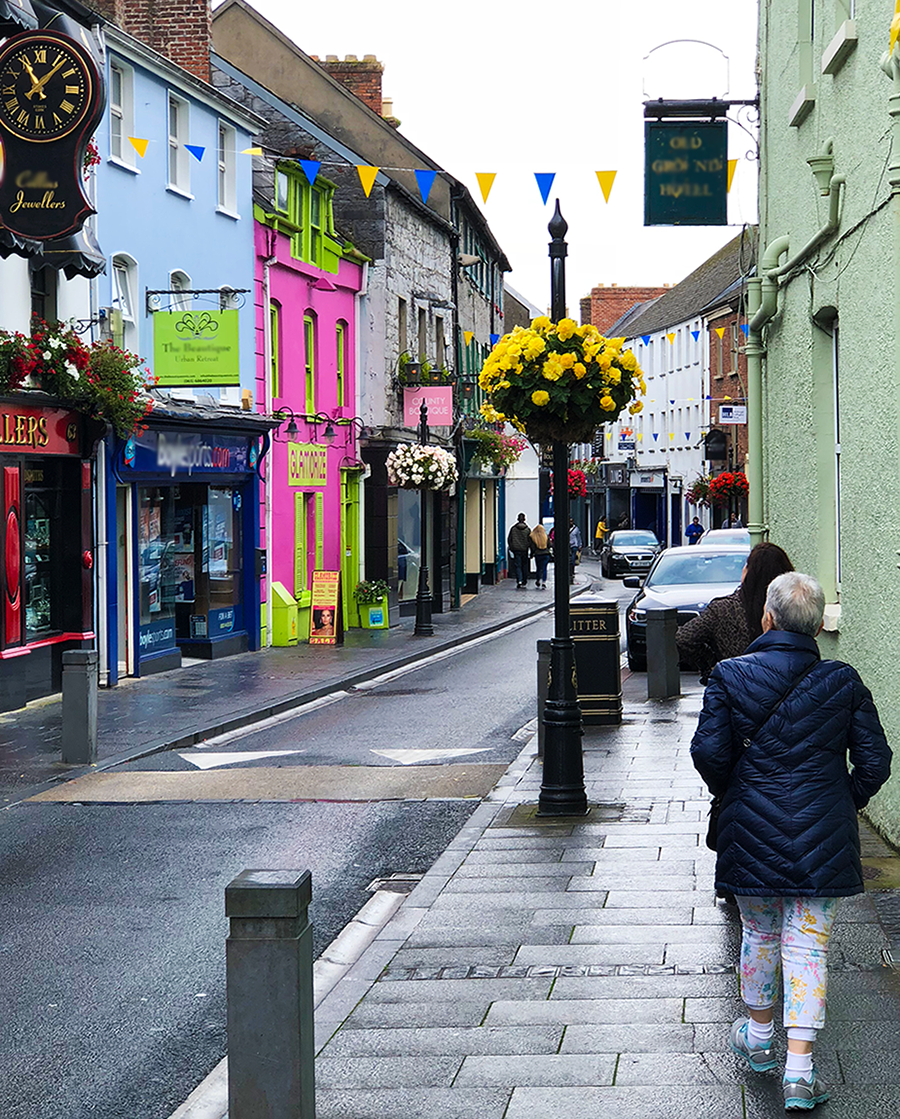 Our morning constitutional also revealed something that would be reinforced again and again for the duration of our trip—Irish towns get going considerably later than their American counterparts. We finally got the morning coffee we had been craving at 7:30 when a proprietor was nice enough to open the door “early” for us. It was a tiny place. When a local farmer squeezed past the two of us to deliver the day’s box of fresh fruits and vegetables, the place was basically at full capacity. Somehow that lent to its charm, and it was certainly a nice departure from the environment found in a U.S. chain without any loss in quality, as the coffee served in Ireland proved top-notch for the duration of our stay. (Our tour guide put it this way: “Ireland has made a successful transition from tea to coffee and tea.”)
Our morning constitutional also revealed something that would be reinforced again and again for the duration of our trip—Irish towns get going considerably later than their American counterparts. We finally got the morning coffee we had been craving at 7:30 when a proprietor was nice enough to open the door “early” for us. It was a tiny place. When a local farmer squeezed past the two of us to deliver the day’s box of fresh fruits and vegetables, the place was basically at full capacity. Somehow that lent to its charm, and it was certainly a nice departure from the environment found in a U.S. chain without any loss in quality, as the coffee served in Ireland proved top-notch for the duration of our stay. (Our tour guide put it this way: “Ireland has made a successful transition from tea to coffee and tea.”)
Knowing that this morning was to be one of the last times we could freelance as tourists without the tyranny of a tight time schedule, we leapt at the chance to look around one more attraction, the Clare Abbey.
Physically only a few blocks away from downtown, historically the distance is more like 1000 years. The chance to see structures that existed long before the U.S. was a gleam in our Founding Fathers’ eyes is part of Ireland’s appeal to American tourists. Clare Abbey certainly fits the bill. Dating from 1189, Ennis basically grew up around it. Abbey ownership has an extremely long and convoluted history—which is endemic of Irish history in general—with ownership shifting back and forth, often between Catholic and Protestant interests. The good news is, both these flavors of Christianity today work together to keep the oldest part of the building intact. Most of what you see in the photo below is from the 14th Century. You can see it from another angle in the photo leading off this post.
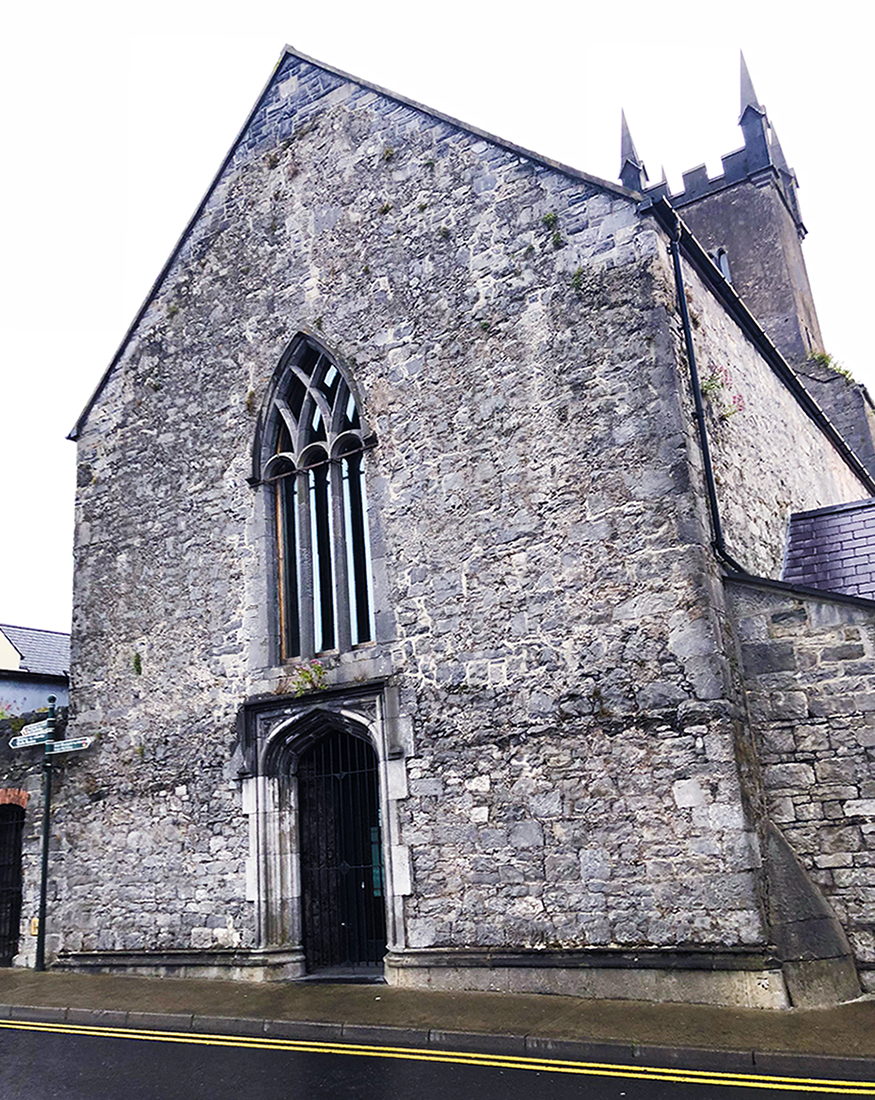 Before long it was time to meet up with the rest of the tour, and begin the more formal part of our vacation. Were cool convenience stores in our future? Only time would tell. For now we’ll leave you with another automotive shop we stumbled across at nighttime, packed in tightly next to other non-vehicle-related establishments. It looks kind of spooky. We can only assume vehicles enter through the rear.
Before long it was time to meet up with the rest of the tour, and begin the more formal part of our vacation. Were cool convenience stores in our future? Only time would tell. For now we’ll leave you with another automotive shop we stumbled across at nighttime, packed in tightly next to other non-vehicle-related establishments. It looks kind of spooky. We can only assume vehicles enter through the rear.
See you soon.
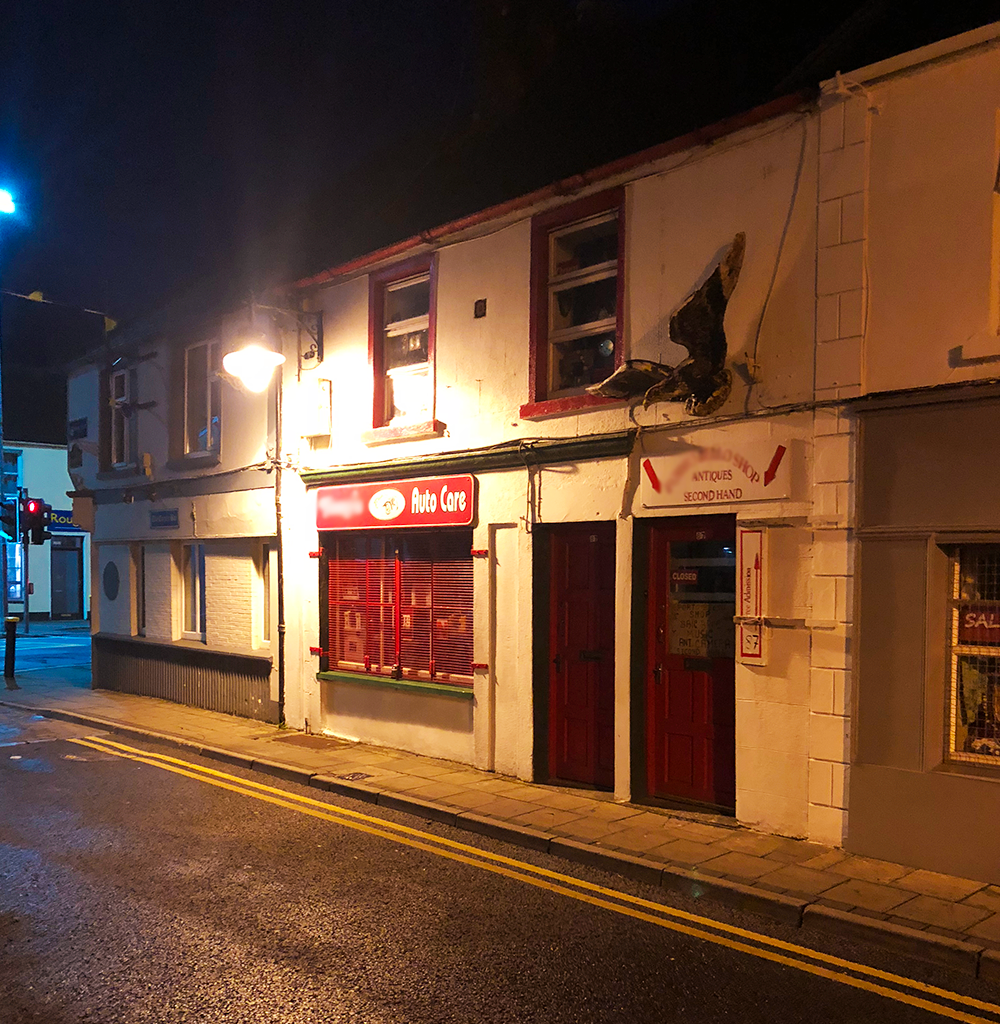 Click here to proceed to Part 3 of this adventure.
Click here to proceed to Part 3 of this adventure.

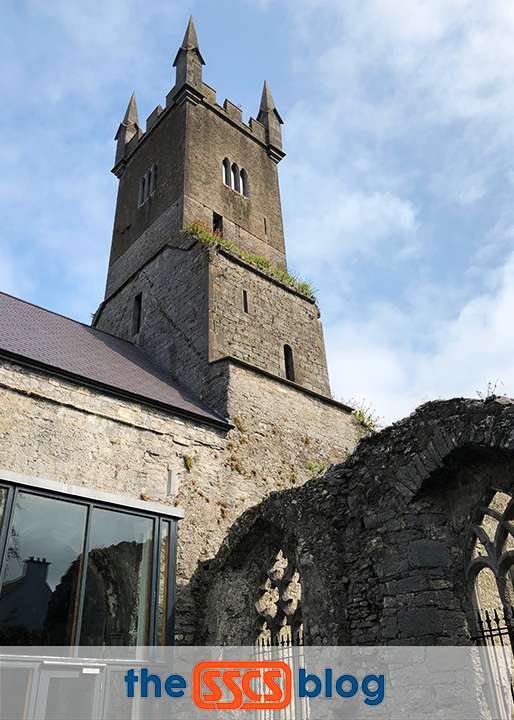
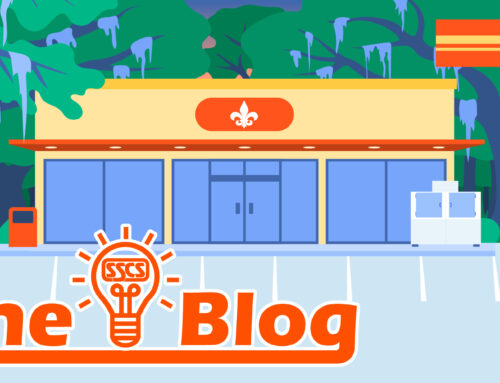




Leave A Comment